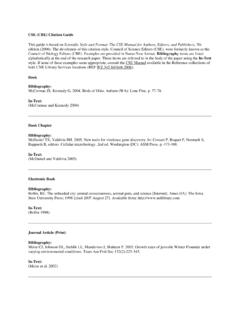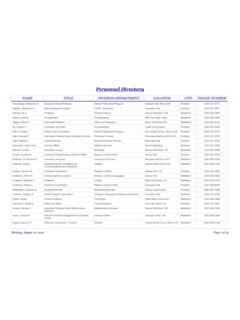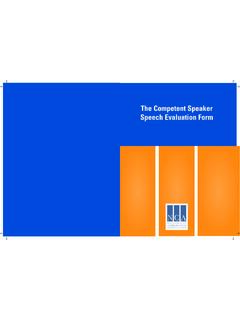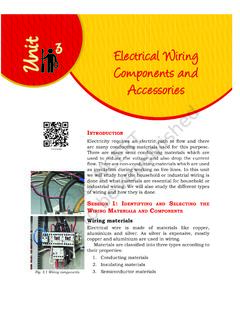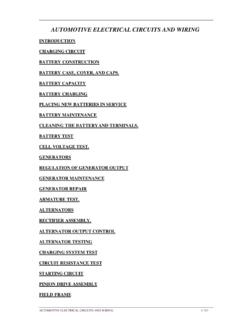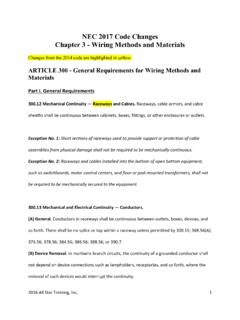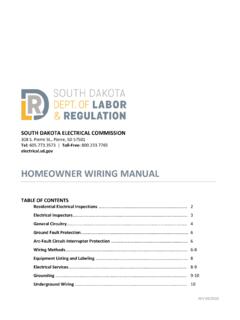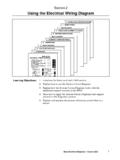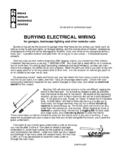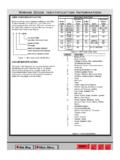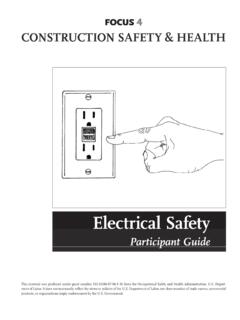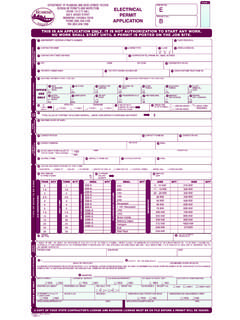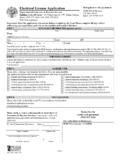Transcription of Electrical Safety NFPA 70E - University of New England
1 Electrical Safety NFPA 70 EHow Electricity Works Operating an electric switch is like turning on a water faucet. Behind the faucet or switch there must be a source of water or electricity with something to transport it, and with a force to make it flow. In the case of water the source is a pump, and the force to make it flow through the pipes is provided by the pump. For electricity, the source is the power generator. Current travels through Electrical conductors (wires) and the force to make it flow, measured in volts, is provided by a Electrical Terminology Current: the movement of Electrical charge Resistance: opposition to current flow measured in ohms Voltage: a measure of Electrical force Conductors: substances, such as metals, that have little resistance to electricity Insulators: substances, such as wood, rubber, glass, and bakelite, that have high resistance to electricity Grounding.
2 A conductive connection to the earth which acts as a protective measureDangers of Electricity On average, a worker is electrocuted every day Causes 12% of young worker workplace deaths Takes very little electricity to cause harm Significant risk of causing firesEffects on the Human Body 1 mA: Can be felt by the body 2-10 mA: Minor shock, might result in a fall 10-25 mA: Loss of muscle control, may not be able to let go of the current 25-75 mA: Painful, may lead to collapse or death 75-300 mA: Last for 1/4 second, almost always immediately fatalTypes of Electrical Injuries There are four main types of Electrical injuries.
3 Electrocution (death due to Electrical shock) Electrical shock Burns FallsIf Electrocution Occurs Call for help DO NOT touch the victim or the conductor Shut off the current at the control box If the shutoff is not immediately available, use a non-conducting material to free the victim If necessary and you know how, begin CPR when current is stopped In dealing with electricity, never exceed your expertiseElectrical Shock Received when current passes through the body Severity of a shock depends on: Pathof current through the body Amount of currentflowing through the body Length of timethe body is in the circuitDangers of Electrical Shock Currents greater than 75 mA* can cause ventricular fibrillation (rapid, ineffective heartbeat) Will cause death in a few minutes unless a defibrillator is used 75 mA is not much current a small power drill uses 30 times as muchHow Electrical Shock is Received When two wires have different potential differences (voltages)
4 , current will flow if they are connected together In most household wiring , the black wires are at 110 volts relative to ground The white wires are at zero volts because they are connected to ground If you come into contact with an energized (live) black wire, and you are also in contact with the white grounded wire, current will pass through your body and YOU WILL RECEIVE A SHOCKHow Electrical Shock is Received If you are in contact with an energized wire or any energized Electrical component, and also with any grounded object, YOU WILL RECEIVE A SHOCK You can even receive a shock when you are not in contact with a ground If you contact both wires of a 240-volt cable, YOU WILL RECEIVE A SHOCK and possibly be electrocutedElectrical Burns Most common shock-related.
5 Nonfatal injury Occurs when you touch Electrical wiring or equipment that is improperly used or maintained Typically occurs on the hands Very serious injury that needs immediate attentionFalls Electric shock can also cause indirect or secondary injuries Workers in elevated locations who experience a shock can fall, resulting in serious injury or deathControlling Electrical Hazards Most Electrical mishaps are caused by a combination of three factors: Unsafe equipment and/or installation, Workplaces made unsafe by the environment, and Unsafe work practicesClues that Electrical Hazards Exist Tripped circuit breakers or blown fuses Warm tools, wires, cords, connections, or junction boxes GFCI that shuts off a circuit Worn or frayed insulation around wire or connectionInadequate wiring Hazards A hazard exists when a conductor is too small to safely carry the current Example.
6 Using a portable tool with an extension cord that has a wire too small for the tool The tool will draw more current than the cord can handle, causing overheating and a possible fire without tripping the circuit breaker The circuit breaker could be the right size for the circuit but not for the smaller-wire extension cordWire GaugeWIREWire gauge measures wires ranging in size from number 36 to 0 American wire gauge (AWG)Control Use the Correct Wire Wire used depends on operation, building materials, Electrical load, and environmental factors Use fixed cords rather than flexible cords Use the correct extension cordMust be 3-wire type and designed for hard or extra-hard useOverload Hazards If too many devices are plugged into a circuit, the current will heat the wires to a very high temperature, which may cause a fire If the wire insulation melts, arcing may occur and cause a fire in the area where the overload exists.
7 Even inside a wallGrounding Hazards Metal parts of an Electrical wiring system that we touch (switch plates, ceiling light fixtures, conduit, etc.) should be at zero volts relative to ground Housings of motors, appliances or tools that are plugged into improperly grounded circuits may become energized If you come into contact with an improperly grounded Electrical device, YOU WILL BE SHOCKEDO verhead Power Line Hazards Most people don t realize that overhead power lines are usually not insulated Power line workers need special training and personal protective equipment (PPE)
8 To work safely Beware of power lines when you work in the vicinity with ladders, erecting antennae, moving equipment, Electrical Hazards Ways of protecting workers and preventing Electrical hazards are: Insulation Guarding Grounding Electrical protective devices Safe work practicesInsulation Check insulation prior to using tools and equipment Remove from service any tools or equipment with damaged insulationGuarding of Live Parts Must guard live parts of electric equipment operating at 50 volts or more against accidental contact by: Approved cabinets/enclosures Location or permanent partitions making them accessible only to qualified persons Elevation of 8 ft.
9 Or more above the floor or working surface Mark entrances to guarded locations with conspicuous29 CFR (g)(2)(i)(A)warning signsGuarding of Live Parts Must enclose or guard electric equipment in locations where it would be exposed to physical damage Physical damage to conduit29 CFR (g)(2)(ii)Cabinets, Boxes, and Fittings Junction boxes, pull boxes and fittings must have approved covers Unused openings in cabinets, boxes and fittings must be closed (no missing knockouts)29 CFR (b)(1) and (2)Grounding Grounding creates a low-resistance path from a tool to the earth to disperse unwanted current When a short or lightning occurs, energy flows to the ground, protecting you from Electrical shock, injury and deathImproper Grounding Tools plugged into improperly grounded circuits may become energized Broken wire or plug on extension cord Some of the most frequently violated OSHA standardsElectrical Protective Devices These devices shut off electricity flow in the event of an overload or ground-fault in the circuit Include fuses.
10 Circuit breakers, and ground-fault circuit-interrupters (GFCIs) Fuses and circuit breakers are over-currentdevices When there is too much current: Fuses melt Circuit breakers trip openGround-Fault Circuit Interrupter The GFCI detects a difference in current between the black and white circuit wires This could happen when Electrical equipment is not working correctly, causing current leakage known as a ground fault If a ground fault is detected, the GFCI can shut off electricity flow in as little as 1/40 of a second, protecting you from a dangerous shockSafe Work Practices Never use plugs or receptacles that can alter polarity Properly plug all connecting plug-ins Install and use protective devices Stay away from all unguarded conductors Never overload a circuit or conductorSafe Work Practices Know where the hazards are Properly maintain equipment No exposed parts or energized surfaces Use barriers and devices where appropriate No conductors to wal



